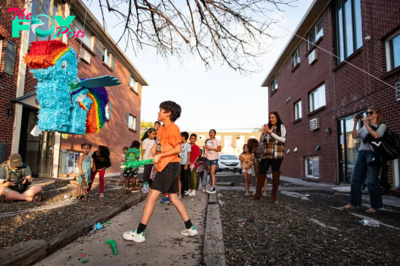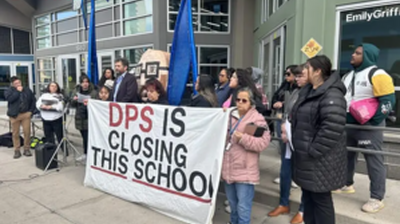Education
The cost of universal pre-K in Colorado: Thousands of at-risk kids got less classroom time
Colorado Gov. Jared Polis’ signature preschool initiative is serving thousands more families than expected in its first year, but its success has come with a costly downside: Fewer low-income children attend full-day preschool today than before the program launched.
The trade-off was laid out in stark terms during Joint Budget Committee hearings last month: The more enrollment grows for universal pre-K, the less state funding will be available for at-risk children to attend full-day preschool.
Under Colorado’s previous state-funded preschool program, which ended July 1, more than 6,000 at-risk 4-year-olds received funding for a full-day classroom slot last school year. This year, the state provided only 3,500 full-day slots to the most at-risk kids — even as funding for preschool has increased and overall enrollment exceeds expectations.
“Those are the kiddos that we think most need access to preschool,” Melissa Mares, the director of early childhood for the nonprofit Colorado Children’s Campaign told The Colorado Sun in an interview. “We saw a shift from a targeted program to one that’s primarily a universal program. Our priority at this point is making sure that that targeted piece is not lost.”
The shift in who benefits from state-funded pre-K has frustrated state budget writers and early childhood advocates alike, even as they applaud the program’s success in reaching so many families.
But in early budget discussions, the JBC appears unlikely to approve new funding — or push the administration to redistribute the money that it has.
“These are hard choices before us,” Rep. Shannon Bird, a Westminster Democrat who chairs the JBC, said at a meeting in February. “They’re hard choices, and I wish we were in a different world where we had a different funding source for universal pre-K.”
☀️ READ MORE
Colorado can’t disqualify Donald Trump for running for president under insurrection clause, U.S. Supreme Court rules
Opposition grows to proposal for national monument along the Western Slope’s Dolores River
1800s-era schoolhouse in tiny Colorado town will reopen to students after sitting vacant for decades
In 2020, Colorado voters approved higher taxes on nicotine and tobacco products to fund the state’s expanded preschool program, which initially promised 10 hours of publicly funded pre-K a week to every 4-year-old in the state.
Later, the Polis administration used its rulemaking authority to up the offer to 15 hours per student — and most families have opted in to the additional classroom time.
All told, 44,845 children were enrolled in Colorado’s preschool program as of January 2024, according to state budget documents. That represents 60% of eligible kids, about 10 percentage points more than the 30,000 children that administration officials had expected to enroll.
Among enrolled 4-year-olds, 68% receive 15 hours a week in funding, while 24% attend 10 hours a week. Just 9% attend 30 hours, the equivalent of a full day.
Under the old program, 28% received full-day pre-K — 20 hours, at the time — out of a total enrollment of 28,000. Over 70% of preschool program participants qualified for free or reduced-price lunch before the pandemic — up to around $36,000 in household income for a family of two.
In the new program, the department considers about half of students to be low-income, but it uses a broader definition: those making up to 270% of the federal poverty line, or around $53,000 for a family of two.
“Thanks to the Colorado Universal Preschool program, total preschool enrollment for low-income children has increased from 2022 to 2023,” a spokesperson for Polis told The Sun in a statement. “There are significant benefits to a universal program that provides more hours and provider choice for all children, and the governor is hoping to build on the program’s success and increase the number of hours all children receive in the coming years.”
Cost of the program to grow past $350 million
For next school year, the department is expanding full-day eligibility to more low-income children by adding “poverty” as a qualifying factor. The rule change could allow an additional 2,900 children to enroll in full-day preschool at a cost of around $12.5 million, according to budget documents — but only if there’s enough money left over to do so after everyone who wants half-day attendance is covered.
Voters reaffirmed their support for the program in November with the approval of Proposition II, which let the state continue collecting the new nicotine taxes when they exceeded initial estimates. But it still hasn’t been enough to cover the extra hours and the higher enrollment without reducing the number of full-day classroom slots.
Mares, with the Children’s Campaign, says her group is asking lawmakers to put in more from the state’s general fund, given the lack of federal support for preschool programming compared with K-12 and higher education. But she acknowledges that’s a tough request in a state that is constitutionally limited from raising taxes without voter approval.
“We do need to think about where is more money coming from for this program to make sure that those kids that most need access to full-day can be confident that they’ll get it,” Mares said.
Without a new funding stream, budget writers are skeptical the state should expand its contributions beyond what voters approved. The state already struggles to adequately fund longstanding programs like higher Education, K-12 and Medicaid.
-

 Education19h ago
Education19h agoWhat would it mean if President-elect Trump dismantled the US Department of Education?
-

 Education3d ago
Education3d agoPhiladelphia students have a new reading and writing curriculum − a literacy expert explains what’s changing
-

 Education3d ago
Education3d agoWhy school police officers may not be the most effective way to prevent violence
-

 Education3d ago
Education3d agoColorado schools commit to protecting students ahead of potential mass deportation
-

 Education6d ago
Education6d agoCampus diversity is becoming difficult to measure as students keep their race and ethnicity hidden on college applications
-

 Education1w ago
Education1w agoFederal judge rules that Louisiana shalt not require public schools to post the Ten Commandments
-

 Education1w ago
Education1w agoCampuses are ground zero in debates about antisemitism − but that’s been true for 100 years
-

 Education1w ago
Education1w agoSocioeconomic status explains most of the racial and ethnic achievement gaps in elementary school

















